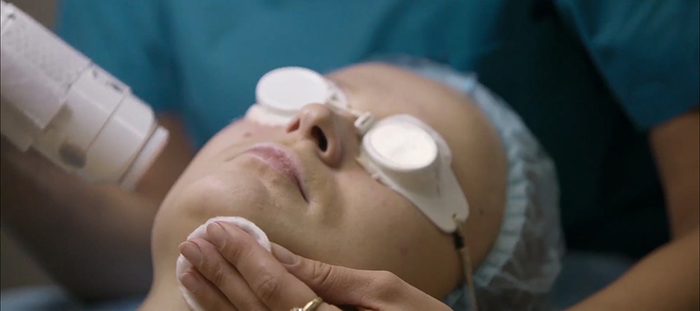Ideal for combating some of the earliest signs of aging, a laser treatment can be a critical component of any skin rejuvenation plan. However, the term “laser” has become a bit of a catch-all phrase for a large category of different modalities.
There are ablative lasers, non-ablative lasers and IPL, or Intense Pulsed Light. Each one works in its own unique way. Finding the right one for you is going to depend on the individual needs of your skin, as well as your ability to tolerate downtime. Dr. Jason Cooper of Jupiter, FL walks us through the different types of lasers, as well as the pros and cons of each.
What is Laser Skin Resurfacing?
As your body’s largest organ, your skin takes a beating. Lifestyle choices such as time spent in the sun, whether or not you ever smoked, and your diet can all take a toll on your skin. Taking good care of it is not just good for your overall health, but it can also make you look more youthful.
One of the fastest and easiest ways to reverse some of the earliest signs of aging on the face, neck and chest is with laser skin resurfacing. This effective, non-surgical procedure uses energy to improve skin tone and texture issues, such as:
- sun spots
- redness
- age spots
- broken blood vessels
- fines lines & wrinkles
- uneven pigment
Choosing the Laser that’s Right for You
The key to a successful laser treatment is choosing the one that is right for your individual needs. Oftentimes, patients will come in to Dr. Cooper’s office saying that they have had a laser treatment when, in fact, they have had an IPL treatment. “I think it’s important to differentiate between a laser treatment and an IPL treatment,” says Cooper.
In order to clear up the confusion, Dr. Cooper breaks down the term lasers into three distinct categories:
- ablative lasers
- non-ablative lasers
- IPL
Each one does something unique for your skin. This is why it is vital that you be assessed in person by a board certified plastic surgeon when considering laser skin resurfacing.
Ablative Lasers: Pros & Cons
Ablative laser treatments, which include the CO2 laser, are the most aggressive of the three categories. They are best for addressing:
- serious sun damage, including brown spots
- deeper lines & wrinkles

The great thing about ablative lasers is that you will see a significant improvement in your skin tone and texture with only one treatment. The downside with these lasers is that there is downtime. Since the laser works by removing the top layer of your skin, you will scab and peel. The duration of your recovery will depend on the depth of treatment, but the peeling can take anywhere from a week to 10 days to resolve while your skin’s redness may last for up to two weeks.
Non-Ablative Lasers: Pros & Cons
Not everyone can commit to two weeks of downtime, nor does every patients’ needs warrant an ablative laser treatment. With non-ablative lasers, the energy does not disrupt the superficial layers of the skin. Ironically, it actually penetrates deeper into your dermis.
Ideal for overall rejuvenation of the face, neck and chest, a non-ablative laser treatment results in significantly less downtime than a treatment with an ablative laser. You can expect to look as if you have a sunburn, but this redness only lasts about 24 hours. The downside of non-ablative lasers is that it requires anywhere from 3-4 treatments, spaced about a month apart, in order to achieve the desired result.
IPL: Pros & Cons
IPL works a little differently. Instead of a single wavelength of light, this energy based treatment blocks out all of the wavelengths except those taken up by pigment and/or blood vessels. This makes IPL best for addressing:
- hyper pigmentation, or age spots
- overall redness
- broken capillaries
The biggest pro of an IPL treatment is that it requires virtually no downtime. However, as with the non-ablative laser, you will need a series of treatments. It typically takes 3-4 sessions before a patient sees significant improvement, but it can always take more.
Reducing Discomfort with Laser Skin Resurfacing
While patients describe an IPL treatment as feeling like a rubber band snapping against the skin, the discomfort from an ablative or non-ablative laser can be significantly more intense. “Our goal is to treat the patients effectively, but also try to do it in as comfortable of an environment that we can facilitate for them in our practice,” explains Dr. Cooper.
He uses topical ointment to help numb the area as well as a chiller. Patients can also opt for PRO-NOX. This inhalation device mixes nitrous oxide and oxygen to help patients relax during their treatments. The great thing about PRO-NOX is that the effects wear off within 20 minutes so that you can still drive yourself home. This has been a game changer for Dr. Cooper’s practice.
Pathology Dictates Laser Choice
When choosing a laser treatment, Dr. Cooper assesses “a person’s ability to tolerate downtime, their pathology, what area they’re looking to treat, and what I think will work best for them.” The treatment has to match the patient’s needs, and the outcome has to be worth the downtime. This is truly the key to a happy laser skin resurfacing patient.
